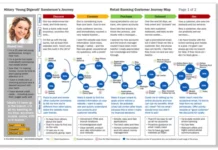
“Consensus is the opposite of leadership.” Said by Mike Pence in the GOP debate on August 23rd.
That sentence is the antithesis of how democracy works. And it’s certainly not true of how B2B buyers of complex solutions make decisions to buy.
Pre-pandemic, an enterprise buying committee consisted of 10 known buyers and 20 unknown contacts from an account engaging with the vendor’s content. Post-pandemic finds 17 known buyers and 96 unknown contacts engaged per account.
This growth in buying committees should be waving a flag in front of marketers. A lack of a collective “yes” (aka consensus) earned with the buying committee will derail the deal.
We all know this. We’ve all been there.
The majority of B2B buyers push conversations with sales reps to the end of their buying process. Yet “no decisions” are up and buying cycles are slower. The trend to self-reliance by buyers means marketing needs to take on this challenge of helping to get everyone on the same page. To use content and experiences to help them guide themselves through learning what they don’t know they don’t know.
Hence, the need for marketing programs to create shared experiences.
When I asked ChatGPT to tell me about “shared experiences” in a complex B2B buying process, it came up with experiences between the vendor sales rep and the buyer. But that’s a limited view. If you wait for sales reps to get into the conversation, you’re already behind and have less chance of gaining the consensus needed to buy your solution. In fact, research shows 90% of buyers choose a vendor that was on a short list at the beginning of the sales process.
What’s a Shared Experience?
B2B marketers often focus campaigns on what they think of as one segment of a market. This is often defined by pulling a list from their database by title — and maybe within an industry.
Ambitious marketers will run several of these campaigns at the same time focused on trying to reach the various personas or members of the buying committee.
The problem is that these campaigns create an experience for one. Most don’t connect the people involved or help them work together toward a solution to the problem.
Even if you’re successful at engaging a few of the people involved in the buying of your solution you haven’t created a shared experience. It’s also important to look at the variety of functional roles involved in the buying process. For example, IT used to buy technology, but now research finds the average number of influencers in a tech purchase is 25 with an almost even split between IT and business roles.
Hank Barnes recently wrote about the impact of surprises in the buying process because all the people involved in buying don’t know the fundamentals of how to buy. So, they encounter surprises that jeopardize their confidence in making a buying decision. Gartner research found that 76% of those who experienced surprises during an expansion sale say that purchase is failing or failing to meet expectations.
Further research conducted by Gartner found a lack of awareness of the steps different roles had to complete to make an expansion purchase, levels of regret, and pessimism. Guess which roles ranked worst? VPs and Directors. What’s interesting is that people in the manager role scored the best across all three — perhaps because they were more engaged in the work.
Many of the projects I work on focus on VPs and Directors. Understandably, assumptions reflect they must have more depth of knowledge given their higher rank. But this isn’t shown in the research.
We assume our buyers know how to buy, but it’s likely they don’t — not totally. And given the growth in the numbers and diversity of those involved, it’s a good bet they also struggle to gain alignment and the confidence to move forward together, whether it’s a net new or expansion purchase.
Yes, each role needs to see the value your solution brings to solving the problem from their perspective.
But that’s not enough on its own. The huge opportunity for influencing revenue is to help each of them also understand the perspectives of the other roles involved. Marketing needs to help facilitate the buyer’s internal conversations that get them to move toward that collective “yes.” You can’t get them to buy if they can’t have a conversation with each other about what to do.
That’s what I mean when I talk about shared experiences.
Think Differently to Create Shared Experiences
Instead of focusing on one perspective or persona, creating shared experiences is about inciting conversations that help to unite buyers. This happens when we can guide them to collaborate and rally around how the purchase helps them meet a company (vs. personal) objective or surmount a cross-functional challenge.
What ideas do you provide to stimulate internal conversations among buyers? Design shared experiences to put your ideas in the room. The aim is to incite conversations and build understanding that results in alignment around solving the problem at hand — together. Aka consensus.
When thinking about “consensus” content, questions to answer include:
- Who will our Champion get pushback from?
- What will they get pushback about?
- What might “Role A” not understand about why “Role B” isn’t on board with Solution X?
- Where might the implementation of the product cross boundaries or create dependencies? And what does each party need to understand about that crossover?
- How does the value promised deliver for individual roles and departments vs. the company? Is it obvious what the implications are for all involved?
Where this gets tricky is that perspectives may run far afield of each other. For example,
- The VP of HR thinks resource skill sets are not up to par and lacks the budget for training.
- The Director of IT thinks about the ease of integration with other systems and the amount of Help Desk requests her team may need to support during the rollout.
- The Head of the business unit worries about how long people will be diverted from work as usual as they learn to adopt the platform.
- The CMO considers the implications for customer experience if the solution doesn’t work as promised.
- The Head of Partnerships suspects the channel will see the solution as encroaching on their revenue stream.
- The end users may be pushing back about having one more solution to deal with and not understand what’s in it for them.
The possibilities can go on and on depending on what solution you’re selling.
The gist is we need to understand the inter-relationships between those involved.
In addition to helping each persona/role mitigate their team and territory concerns, we need to help them align on how the value is worthwhile enough to incent compromise or — even better — how they collaborate to remove obstacles.
Think about shared experiences like water cooler conversations.
From the scenarios above, perhaps suggest a conversation between the CMO and Head of Partnerships to discuss how the rollout can produce more upside for the channel and the customer experience.
Maybe the VP of HR and the Head of the business unit need to discuss how to expedite training efficiently. And then both can talk to the Director of IT about how to streamline help desk support.
Content that Promotes Shared Experiences
Building the business case is often considered a sales responsibility. But as buyers try to self-educate and shore up their confidence to move forward, I propose that marketing has a role to play here. For without advancement and at least moderate consensus there won’t be a productive conversation with sales.
Marketers need to provide an assist with eliminating obstacles to help buying committees advance by helping them learn and understand what they may not know. Most importantly, to eliminate surprises that buyers are unprepared to address.
Some examples of content useful in stimulating shared experiences include:
- In-depth case studies that show why a customer like them chose the solution and how they overcame obstacles to make the purchase decision — in addition to the value received. Buyers want to know what people like them did and how they navigated. Case studies can be more effective if they get beyond the glossed-over story and stats and into the nuts and bolts.
- Checklists of questions to ask and answer between roles who may have dependency overlaps – options for dealing with them, examples of ways customers have solved those problems, even if veiled. Think “How to discuss X with your VP of HR” type of content created for each of the primary buyer personas you engage.
- Webinars that showcase a panel from a customer talking about how they reached a consensus. Or webinars with a panel of one role discussing why they chose X, what obstacles they had to overcome, what they learned, and what outcomes they achieved for their teams and the company.
The secret sauce here isn’t the format as much as it is the context in relation to helping with knowledge transfer that addresses the different perspectives involved.
Become the “Anchor” for Your Buyers’ Shared Experiences
Building awareness and engaging buyers with insights about solving their problems early in the process is critical for getting on their shortlist. Sharing new ideas and helping them understand the perspectives of others involved will help your ideas become the “anchors” your buyers use in conversations as they work to advance toward purchase.
This means marketers need to focus on the “job” content must do, not solely creating content for only one persona’s perspective. Shared experiences require a strategy executed with a storyline featuring multiple personas. And this includes the handoff mid-story to your sales team for them to continue in conversation with buyers.
Creating effective shared experiences results in more opportunities, faster momentum, and fewer deals resulting in no decision.



